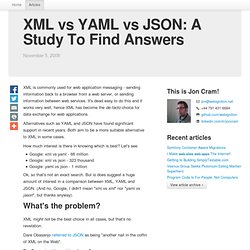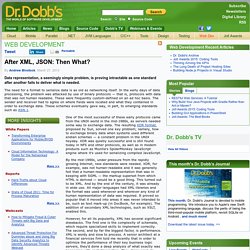

XML vs YAML vs JSON: A Study To Find Answers. XML is commonly used for web application messaging - sending information back to a browser from a web server, or sending information between web services.

It's dead easy to do this and it works very well, hence XML has become the de-facto choice for data exchange for web applications. Alternatives such as YAML and JSON have found significant support in recent years. Both aim to be a more suitable alternative to XML in some cases. How much interest is there in knowing which is best? After XML, JSON. Then What? The need for a format to serialize data is as old as networking itself.

In the early days of data processing, the problem was attacked by use of binary protocols — that is, protocols with data that was not human readable. These were frequently custom-defined on an ad hoc basis. The sender and receiver had to agree on where fields were located and what they contained in order to exchange data. These schemes eventually gave way, in part, to emerging standards such as ASN.1.
TOML. YAML. GData. BSON. XML. Open Data Protocol. JSON. Extensible Data Notation (EDN)